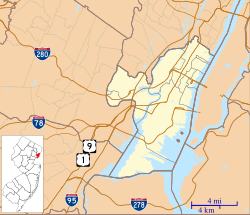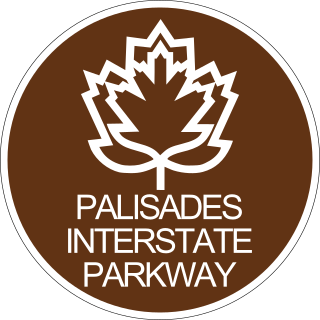
The Palisades Interstate Parkway (PIP) is a 38.25-mile (61.56 km) controlled-access parkway in the U.S. states of New Jersey and New York. The parkway is a major commuter route into New York City from Rockland and Orange counties in New York and Bergen County in New Jersey. The southern terminus of the route is at the George Washington Bridge in Fort Lee, New Jersey, where it connects to Interstate 95 (I-95), US 1-9, and US 46. Its northern terminus is at a traffic circle in Fort Montgomery, New York, where the PIP meets US 9W and US 202 at the Bear Mountain Bridge. At exit 18, the PIP forms a concurrency with US 6 for the remaining duration of its run.

The Palisades Interstate Park Commission (PIPC) was formed in 1900 by Governors Theodore Roosevelt of New York and Foster Voorhees of New Jersey in response to the quarrying operations along the Palisades Cliffs of New Jersey. The Palisades, a National Natural Landmark that are also called the New Jersey Palisades or the Hudson River Palisades, are a line of steep cliffs along the west side of the lower Hudson River in Northeastern New Jersey and Southeastern New York in the United States. After its formation, the PIPC quickly moved to acquire the lands at the base of the Palisades to stop quarrying operations in both New York and New Jersey. The commission consists of ten commissioners, five appointed by each governor, and was ratified by an Act of Congress in 1937 when its interstate compact was approved. Today, the Commission owns and operates more than 125,000 acres of public parkland in New York and New Jersey including 21 state parks, 8 historic sites, and the Palisades Interstate Parkway. These parks are visited by more than 7 million people annually.

Bergenline Avenue is a station on the Hudson–Bergen Light Rail (HBLR). The intermodal facility is located on 49th Street between Bergenline Avenue and Kennedy Boulevard in Union City, New Jersey, near its border with West New York and North Bergen. The station is the first and only completely underground station on the network and opened for service on February 25, 2006.

The Central Railroad of New Jersey Terminal, also known as Communipaw Terminal and Jersey City Terminal, was the Central Railroad of New Jersey's waterfront passenger terminal in Jersey City, New Jersey. The terminal was built in 1889, replacing an earlier one that had been in use since 1864. It operated until April 30, 1967.

The Hackensack Water Company Complex is a set of historic buildings in Weehawken, New Jersey, registered in the U.S. National Register of Historic Places. The Hackensack Water Company, a predecessor of Suez North America, developed water supply and storage in northeastern New Jersey from the 1870s to the 1970s, initially to provide service to the city of Hackensack and the towns of North Hudson. Originally its headquarters and major facilities were located at Hackensack, in Bergen County. Under Robert W. de Forest, who ran the Hackensack Water Company for 46 years beginning in 1881, the company constructed new facilities and moved its headquarters to Weehawken in Hudson County, setting up offices in a brick water tower, part of the present complex.

The Beacon is a mixed-use development located on a 14-acre (57,000 m2) site on Bergen Hill, a crest of the Hudson Palisades and one of the highest geographical points in Jersey City, Hudson County, in the U.S. state of New Jersey. The Beacon, which occupies the Jersey City Medical Center's rehabilitated original complex, creates the northeastern corner of the Bergen-Lafayette section and is just east of McGinley Square. The Beacon includes 2,000,000 square feet (190,000 m2) of residential and retail space, approximately 1,200 luxury residences and 80,000 square feet (7,400 m2) of retail space.

The Hoboken Land and Improvement Company Building, is located in Hoboken, Hudson County, New Jersey, United States. The building was designed by Charles Fall and was built by Myles Tierney in 1889. The building was added to the National Register of Historic Places on July 3, 1979. The building housed the offices of the Stevens family real estate holding corporation the Hoboken Land and Improvement Company. The building is notable for its high quality brickwork, with recessed panels and contrasting color mortars.
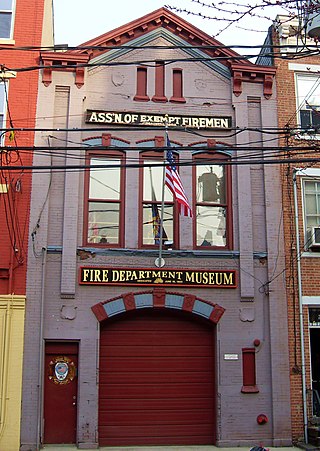
The Association of Exempt Firemen Building is located in Hoboken, Hudson County, New Jersey, United States. The building was designed by Francis G. Himpler and was built in 1870. The building was added to the National Register of Historic Places on March 30, 1984 as Assembly of Exempt Firemen Building. The building serves as a firefighters' union hall and as a museum of Hoboken firefighters' memorabilia, the Hoboken Fire Department Museum.

Hoboken City Hall, is located in Hoboken, Hudson County, New Jersey, United States. The building was designed by Francis G. Himpler and was built in 1883. The building was added to the National Register of Historic Places on January 1, 1976. The building is a Second Empire structure modified to a Beaux Art Classicism design.

The Jefferson Trust Company is a historic building located in Hoboken, Hudson County, New Jersey, United States. The building was built in 1912 and was added to the National Register of Historic Places on February 13, 1986. The original trust company failed during the Great Depression and the building passed on to a succession of owners. The building was constructed using granite and brick. Much of the original plaster interior remains intact. The building underwent a renovation into luxury condos in the 2000s.
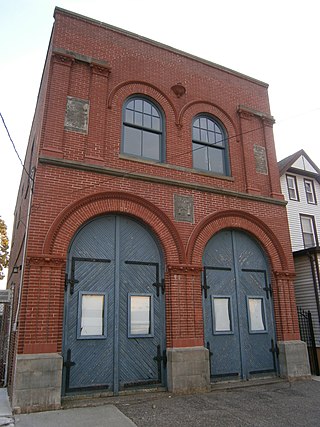
Highland Hose No. 4 is located in Kearny, Hudson County, New Jersey, United States. The firehouse was added to the National Register of Historic Places on May 29, 1987. The firehouse was constructed in 1894 to be used by Highland Hose No. 4. The firehouse is currently used as a meeting hall for the Firemen's Mutual Benevolent Association. Locals refer to the building as "The Exempts".

County Route 617 is 4.55-mile (7.32 km) long and follows one street, Summit Avenue along the ridge of the Hudson Palisades in Hudson County, New Jersey. Its southern end is CR 622, or Grand Street, at Communipaw Junction in the Bergen-Lafayette Section of Jersey City. Its northern end is CR 691, 32nd Street, a section of the Bergen Turnpike, in Union City.

Shippen Street is an east-west street in Weehawken, New Jersey. The eastern terminal, a cobblestone double hairpin turn is listed on the New Jersey Register of Historic Places. Shippen Street was developed at the start of the 20th century as part of the Weehawken Heights, one of the town's residential neighborhoods.

The North Hudson Railway Company built and operated a streetcar system in Hudson County and southeast Bergen County, New Jersey before and after the start of the 20th century. It was founded by Hillric J. Bonn who became the first President in 1865 and served for 26 years until his death, and eventually taken over by the Public Service Railway. In its endeavors to overcome the formidable obstacle of ascending the lower Hudson Palisades, or Bergen Hill, it devised numerous innovative engineering solutions including funicular wagon lifts, an inclined elevated railway, an elevator and viaducts.

The Bayonne Community Museum is located in the Bergen Point section of Bayonne, Hudson County, New Jersey, United States.

Palisade Avenue is the name given to a historic road which parallels the eastern crest of Hudson Palisades in northeastern New Jersey. It travels between Jersey City and Fort Lee, passing through Jersey City Heights, North Hudson, and Cliffside Park, with various parts carrying Hudson and Bergen county route designations. The avenue re-aligns itself at several places along its route as it crosses traditional municipal boundaries created in the 19th century. As a primary route running along the top of the Hudson Palisades, many segments offer scenic views of the Hudson River and the New York skyline. Since 2020 there is proposed state legislation to restrict building heights that would rise above the cliffs on the eastern side of Palisade Avenue along the entire corridor from Jersey City to Fort Lee.

Ficken's Warehouse, is located in Bergen Hill, Jersey City, Hudson County, New Jersey, United States. The building was added to the National Register of Historic Places on June 14, 1984. The building was built in 1910 by John H. Fickens and used as a stable and warehouse. The building was later used as the Bergen Station Post Office for 50 years before being converted to residential use.

Edwin A. Stevens Hall is located in Hoboken, Hudson County, New Jersey, United States. The building was added to the National Register of Historic Places on February 4, 1994. It was designed by Richard Upjohn and built in 1870. It was named after Edwin Augustus Stevens and used as the main building for the Stevens Institute of Technology. The renowned DeBaun Auditorium, which is over 100 years old, is located in this building. The building is currently used as the Charles V. Schaefer, Jr. School of Engineering and Science.
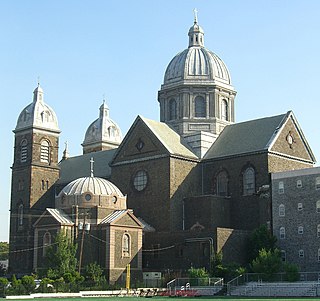
The Monastery and Church of Saint Michael the Archangel, known locally as Saint Michael's Monastery Church, is a state and national historic place in Union City, New Jersey, United States. Formally opened in 1869 and completed in 1875, the grounds of the complex are bounded West Street and Summit Avenue between 18th and 21st Streets. The small street leading to its front entrance from the east is called Monastery Place. At one time the largest Roman Catholic church in Hudson County, it has since become home to a Presbyterian congregation while part of the grounds are used for housing and education. At one time its walls were adorned by artwork by Hildreth Meière, until rain damage prompted their removal from public view.

The Blackledge–Kearney House is located within the Palisades Interstate Park in the borough of Alpine in Bergen County, New Jersey, United States. The historic stone house was built around 1750 and was documented as Cornwallis Headquarters by the Historic American Buildings Survey (HABS) in 1936. It was added to the National Register of Historic Places on July 24, 1984, for its significance in architecture and exploration/settlement. It was listed as part of the Early Stone Houses of Bergen County Multiple Property Submission (MPS). Lord Cornwallis was believed to have used the house as a temporary headquarters during his crossing of the Hudson River in 1776, but modern historians dispute this claim.

